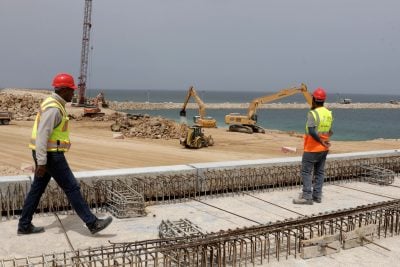Thirty-two-year-old Gambian economist Marie Ba used to buy most of her clothes online from British fashion retailer ASOS. But when she wanted to update her closet with some tailored wax print African dresses, she took a chance ordering through Ghana’s KIKI Clothing platform. “I was looking for something well designed and fitted, and it’s lovely to support brands based in West Africa, while looking quite unique in their pieces,” she says.
Within five working days the clothes were delivered by DHL from Accra, to her door in Gambia’s largest city, Serekunda. And Ba became part of a growing ecosystem of fashionistas purchasing their clothes within the expanding African e-fashion market.
African fashion has revelled in tremendous media interest recently. Beyoncé helped propel Senegalese designer Sarah Diouf’s Tongoro brand to international fame when the singer wore a patterned dress and wide-leg pants on holiday last year. Naomi Campbell and Alicia Keys are other megastars spotted wearing African-designed clothes.
Sub-Saharan Africa’s clothing and footwear market is worth $31bn, according to Euromonitor. The growth has prompted the expansion of foreign and local brands into the African clothing market. Companies are fulfilling increasing orders from the African diaspora, particularly in Europe and America, while sales of Ankara gowns and African print dresses are also popular among non-African consumers. This has led to the creation of African-based e-fashion platforms.
“We export African culture no matter where you are,” says Malian-born Moulaye Tabouré, the CEO of Afrikrea, an online marketplace that allows users to sell African clothing to over 100 countries. The Abidjan-based tech startup secured an additional $1m funding round in February, money Tabouré says will allow the business to grow its developer team, and expand its mobile technology and marketplace.
The company boasts a minimalist and user-friendly website, and says 5000 designers use its platform. These designers build an online “shop” with digital tools provided by Afrikrea. They then set the prices and communicate directly with customers, who are able to stagger their payments. Afrikrea then deducts a commission of 10-15% per sale, and says it has facilitated over 4m sales since the company’s 2016 inception. The biggest market is the US, followed by France and the rest of the EU.
“Our target is to get the infrastructure growing, so we get at least 50% of our sellers from Africa,” says Tabouré. “The idea is to get people in Africa to say, ‘Maybe this is the best place to set up my business.’ But the biggest issue is to be able to organise, and sustain the growth.”
E-commerce in sub-Saharan Africa is in its nascent stage but it’s showing enormous potential as smartphones proliferate across one of the world’s youngest and fastest-growing populations.
A 2017 report by Statista estimated the e-commerce sector in Africa generated $16.5bn in revenue that year. The research firm currently predicts that revenue in the sector will reach $27.7bn in 2020 and rise to $47bn by 2024. Online growth is being driven by the under-35s. Rubab Abdoolla, senior analyst of beauty and fashion at Euromonitor, says the e-commerce sector is being driven by “the increasing number of working mothers who are being supported by rapid adaptation to internet retailing”.
The wider African e-commerce landscape is being pushed by sales in fashion. Statista predicts revenue at $8.3bn in 2020 and projects an annual growth rate of 14.2% between 2020 and 2024. But this expanding e-fashion market faces major challenges.
Overcoming challenges
West Africa is a major cotton-growing region, but its textile industry struggles to compete with cheap clothes made in Asia. Since the 1980s, most of Africa’s textile industries have been wiped out and a generation of skilled workers have been lost. Textile manufacturing in the region is estimated to have fallen by more than 75% in that time. Transporting clothing within the continent and beyond can be problematic, with expensive export costs and border difficulties.
“The number one business constraint I have is definitely the customs,” says Tabouré. “If African governments would realise the potential of having free trade between African countries, and facilitating customs for people shipping outside of Africa – especially with Europe – then there would be an extremely good advantage.
“In the US, we have an agreement [the US’s African Growth and Opportunity Act] that allows us to ship without customs up to $700. If we could have the same agreement with Europe, then that would change the game.”
These challenges are not stopping self-taught Ghanaian designer Felicia Parker. The Afrikrea user is able to sell her La Mode Afrique brand of kente cloth styles and other items to a growing customer base in London, Paris and elsewhere on the continent.
“When an order is placed, DHL will come to pick up the clothing from my door, and take it to most places in the world,” she says.
“The internet has made it really easy for anyone to purchase whatever designs they want, in the comfort of their home and workplace In the next five years, I hope I’ll have a big factory here in Ghana, and shop branches worldwide, that are full of African print fashion.”
This article was first published in African Business Magazine in April, 2020.
Want to continue reading? Subscribe today.
You've read all your free articles for this month! Subscribe now to enjoy full access to our content.
Digital Monthly
£8.00 / month
Receive full unlimited access to our articles, opinions, podcasts and more.
Digital Yearly
£70.00 / year
Our best value offer - save £26 and gain access to all of our digital content for an entire year!
 Sign in with Google
Sign in with Google 



